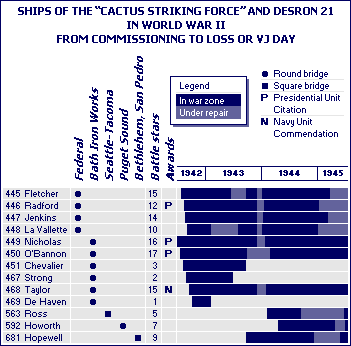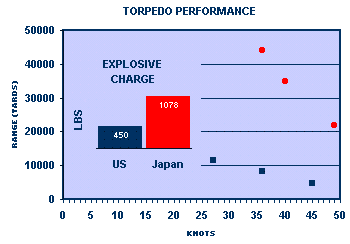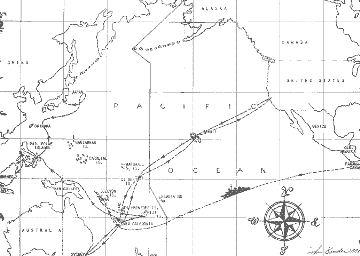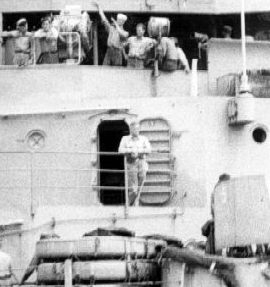

References: DANFS, Friedman, Roscoe.
Ten destroyers—six built at Bath Iron Works, Bath, Maine and four from Federal Shipbuilding & Dry Dock Co., Kearny, New Jersey—were commissioned at the rate of three per month beginning 4 June 1942, the same day as the Battle of Midway. The first of 175 ships of the 2,100-ton Fletcher class—one of the most successful all-around destroyer designs of World War II—they were all sent to Guadalcanal, where they went into combat on arrival.
In 1943, after the last-built among them (De Haven) was lost, the remaining ships—the first nine Fletchers commissioned—were formed into DesRon 21. Their ensuing records—and the records of the replacement ships that joined the squadron later—reflected the varying fortunes of war:

References: DANFS, Roscoe.
A great strength was the intensity and dedication of their crews. “Each old sailor cherishes his own private inner shrine that is filled with the memories of those great old guys he knew so long ago,” wrote Al Grimes of the Strong. “They did what was needed when it was needed, regardless of the hours and risk—and it was no big deal. Each of us knew many like this; they were everywhere.”
While three ships (Radford, Nicholas and O’Bannon) were awarded individual Presidential Unit Citations and one (Taylor) a Navy Unit Commendation, all their crews were deserving and all could take pride in their collective accomplishments.
The first three Fletchers—Nicholas, O’Bannon and Fletcher—arrived at Guadalcanal as convoy escorts in the fall of 1942. Due to the desperate shortage of ships there, they were not organized into a division, but deployed individually as needed. In January 1943, they plus Radford and De Haven were formed into the “Cactus Striking Force” (Cactus was the code name for Guadalcanal) under Capt. R.P. Briscoe, ComDesRon 5. In March, those present were formed into DesRon 21 under Capt. Francis X. McInerney, with the Nicholas as flagship (see table below).
De Haven, Strong and Chevalier were lost in 1943 and La Vallette and O’Bannon went home early due to battle damage, but the surviving ships returned together to California for refit late that year. Later, even as the addition of Hopewell and Ross brought squadron strength back up to nine ships, five were damaged in the Philippines and one off Borneo, which left only three to serve out the war before returning home.
The ten original ships arrived in the South Pacific to face an adversary with torpedoes and night fighting tactics so advanced that their task force and squadron commanders—Callaghan, Wright, Briscoe, Ainsworth, McInerney and Ryan—did not at first suspect the total threat. The torpedo was a destroyer’s most potent weapon, but American torpedoes at the time were faulty—they tended to run too deep and their exploders fired prematurely if at all—while Japanese torpedoes not only worked reliably but packed a more explosive punch, ran much faster and farther, and even could be reloaded during battle. As for tactics, American destroyers were initially mixed in columns with cruisers, which prevented them from striking effectively or evading independently.
For many crewmembers aboard in 1942 and ’43, before reinforcements arrived and before their own tactics and equipment could be refined by battle experience, it seemed only a matter of time until their own ship would be the one blown out of the water by a more numerous and better equipped enemy, like so many others they all had seen. Every destroyer screened convoys, bombarded shore targets and was shot at from land, sea and air. Privately, every man in his own individual way had to face standing out into “Ironbottom Sound” or probing up the “Slot,” where pure luck—more than gallantry or preparedness—would determine which ships would be sunk and which ones would survive. At times they did this nightly without sleep, with only the effectiveness of their radar and guns to save them from much more severe losses.

|
Japan |
44,000 @ 36 |
35,000 @ 40 |
22,000 @ 49 |
|
U.S. |
11,500 @ 27 |
8,200 @ 36 |
4,800 @ 45 |
| Note: a torpedo would always be fired at the highest speed possible for the selected range—thus at 10,000 yards, a Japanese torpedo would be fired at 49 knots while an American torpedo would be fired at 27 knots. | |||
Eventually, the hazards they and others faced at Guadalcanal and New Georgia were translated by Capt. Arleigh Burke into doctrine that first Moosbrugger, then Merrill and Burke’s own DesRon 23—armed at last with torpedoes that worked—applied with devastating effect in the northern Solomon Islands. Matched and then surpassed in effectiveness, cut off from resources, and eventually overwhelmed by force of numbers, the enemy turned his tactics from stealth to suicide. In response, ships were refitted to counter the changing threat and sent back out to meet it.
The overall costs were great: DesRon 21 ships were torpedoed three times, mined four times, and hit four times by shore batteries, with a total of 372 crewmembers killed and many more wounded. But the benefits were also great: they sank or helped sink ten submarines and numerous surface ships, shot down many dozens of aircraft, and rescued more than 1,800 sailors and downed airmen. Meanwhile, the Navy assimilated their experiences into destroyer doctrine, culminating in deadly torpedo attacks by DesRons 24, 54 and 56 at Surigao Strait that helped sink two battleships in less than an hour.

Taylor’s World War II career traces the squadron’s history.
“The record of the Nicholas is in a sense the record of one entire phase of the Pacific war,” said Admiral Nimitz in 1944. Her squadron’s unwritten record also reflected the spectrum of wartime experiences aboard a destroyer. There were horrifying moments: the torpedoes that passed below without hitting, the bombs that narrowly missed and the splinters that penetrated metal in the Solomons found sequels in the kamikaze that clipped only the radar and the typhoon that brought green water crashing over the bridge. But there were also good times: the Esther Williams movies on the foredeck or the fantail, the monkey smuggled aboard that escaped up the mast, the baseball games and the “steak break” with the hospital ship nurses in Subic Bay, the ice cream that came over from carriers in return for downed pilots.

Courtesy R. Townshend, Jr. collection
Admiral Halsey on board Missouri, 15 August 1945, viewed from Nicholas.
For all the ships of DesRon 21, there was always the tropical heat, the boredom of day-to-day life far from home, the never-ending tasks such as chipping paint only to paint it over again, replenishment, gunnery drill, and spam. Perhaps only two aspects of these ships’ histories were dissimilar to those of other contemporary destroyers: that none of them was seriously damaged or sunk by a kamikaze, and that the three luckiest of them were given the place of honor in the vanguard of the ships entering Tokyo Bay to end the war. Even as that day approached, however, their crews were preoccupied with normal shipboard duties and thinking about going home, hardly noticing whether anyone was taking photographs or recording their ships’ names for posterity.
Admiral Halsey’s perspective was different. “The history of the Pacific war can never be written without telling the story of the USS O’Bannon,” he wrote. “Time after time the O’Bannon and her gallant little sisters were called upon to turn back the enemy. They never disappointed me. . . .”
Perhaps, as he looked out from his flagship Missouri on the day Japan agreed to surrender (above), he was thinking ahead to the morning two weeks later when he would enter Tokyo Bay. Close aboard: Nicholas, O’Bannon and Taylor, three DesRon 21 veterans remaining at sea; the ships he had chosen to escort him there.
Click for an introduction to the individual ships of DesRon 21 in World War II.